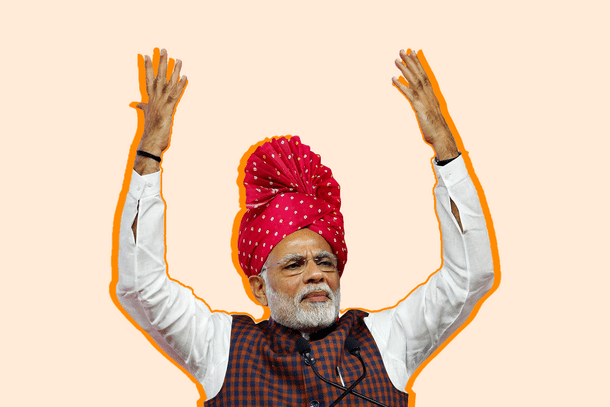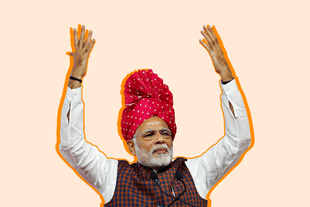Ideas
Five Soft Hindutva Ideas For Modi 3.0 That Needn't Raise The Hackles Of 'Secular' Allies
R Jagannathan
Jun 20, 2024, 11:32 AM | Updated Aug 05, 2024, 03:41 PM IST
Save & read from anywhere!
Bookmark stories for easy access on any device or the Swarajya app.


Many diehard believers in Hindutva and equal rights for Hindus have been underwhelmed by the performance of the Narendra Modi government in its second tenure.
So, many are wondering if Modi 3.0 will do anything at all for the majority community, given that there will be 'secular' allies to contend with in the ruling coalition.
The funny thing with Modi 2.0 is that it accomplished some very difficult things: abolished article 370, legislated the Citizenship Amendment Act (though the courts are still capable of messing with it), and got the Ram Mandir constructed in record time.
What it failed to do was the simple things that would outlive it. Here is a list of five things Modi 3.0 can do without raising the hackles of his 'secular' allies too much.
First, bring Indology — Bharatiya history and social sciences — back home. Currently, the world’s most learned Indologists are academics in the US, and they tend to either follow the Marxist school of thought, or view Indian history from an Abrahamic and/or Eurocentric lens.
There is no reason why this hegemony should not be challenged by setting up institutions(s) in India, where chairs are dedicated to the memory of historians with an Indic sensibility.
Among the names that come to mind are terrific historians such as Jadunath Sarkar, R C Majumdar, Nilakantha Sastri, Radhakumud Mookerji, Ram Swarup and Sita Ram Goel, among others.
A key requirement should be that these chairs will be headed by tenured professors who will commit to using an Indic lens, and specifically abandon Marxist or Eurocentric approaches to history.
While some chairs can be created in the revived Nalanda University, there is no reason why private institutions like the one headed by Vikram Sampath should not get generous funding from the government, too.
Second, yoga and ayurveda, both of which originated in India, have a Dharmic core. This can only be retained if India controls global yoga and ayurvedic certifications and invests in their development in India.
The government must fund governing councils for the control and certification of both types of courses, and also support scientific research on improving these bio-spiritual sciences with more funding.
All the schools of yoga and ayurveda should be represented on these regulatory and advisory councils, and any Western deviations like 'Christian yoga' must be rejected as not deserving of the yoga tag.
Labs to validate yogic practices, and also on the efficacy of ayurvedic medicine, should be set up to enable high-quality cures that cannot be hijacked by commercial interests.
Third, socially, India must transcend caste-based inequities even while retaining the social capital associated with various jatis spread all over the country.
A good place to start would be the setting up of a united castes council with a national mandate, to be supplemented by state-level councils to understand and mediate inter-caste disputes.
The aim must be to work out sensible compromises at the local level. If a Dalit is not allowed to ride a horse to his wedding, this council, and its local members, should be able to intervene and achieve a consensus.
Hindutva is weakened every time we allow caste-based conflicts to spiral out of hand.
If the BJP can end 90 per cent of these conflicts in the next five years, it will achieve the central aim of Hindutva — which is to unify Hindu castes and tribes into a Dharmic whole. It is difficult to see how such an achievement will not result in a fourth term for the BJP, this time with a clear majority of its own.
Fourth, to integrate India from north to south, east to west, we must strengthen our regional languages. This means not only teaching in the mother tongue for early schooling, but taking the regional route further and deeper.
All major Indian literature or work in any language should be translated and available in every other Indian language. The same goes for translations from English, French, German and Spanish, not to speak of Asiatic languages like Chinese, Japanese and Russian.
Every state should be given grants to set up translation labs, some aided by artificial intelligence technology, to translate its own best literary and other works into other Indian languages. And vice-versa.
Ideally, Uttar Pradesh (or Bihar) should set up Tamil, Kannada, Malayalam and Telugu departments, where all works in Hindi will be translated into these southern languages. Eastern and southern states can set up departments to translate their literature into Hindi, Marathi, Gujarati and Bengali, among others.
This regional network will not only create a pool of dual-language expertise among scholars, but also pave the way for rejuvenating regional languages.
All Indian languages will be enriched by the addition of words and idioms from other Indian languages. Creating 5-10 major translation centres in major states will set off a revolution in national integration through linguistic growth.
Fifth, and it is time to set up a history, truth and reconciliation commission at the central level, and replicate it in states.
This commission must be manned by Indic scholars and non-Marxist public intellectuals, and should be able to draw on history and other kinds of expertise so that the past can never be used to create divisive agendas — especially those manufactured by the left.
History will always be contested, but there is a need for communities to acknowledge the past instead of just air-brushing it with manufactured 'secular' history and pretending that there really was a Ganga-Jamuni tehzeeb. If communities are to go forward in amity, the past has to be acknowledged so that we can move ahead.
These are five good places to start a soft Hindutva project that even secular-minded parties can live with.
Jagannathan is former Editorial Director, Swarajya. He tweets at @TheJaggi.





